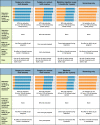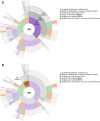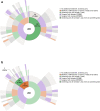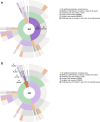Preferences for breast cancer prevention among women with a BRCA1 or BRCA2 mutation
- PMID: 33014209
- PMCID: PMC7526374
- DOI: 10.1186/s13053-020-00152-z
Preferences for breast cancer prevention among women with a BRCA1 or BRCA2 mutation
Abstract
Background: Women with a BRCA1 or BRCA2 mutation have high lifetime risks of developing breast and ovarian cancer. The decision to embark on risk reduction strategies is a difficult and personal one. We surveyed an international group of women with BRCA mutations and measured choices and sequence of breast cancer risk reduction strategies.
Methods: Women with a BRCA1/2 mutation and no previous cancer diagnosis were recruited from the US, Canada, the UK, Australia, and from a national advocacy group. Using an online survey, we asked about cancer-risk reduction preferences including for one of two hypothetical medicines, randomly assigned, and women's recommendations for a hypothetical woman (Susan, either a 25- or 36-year-old). Sunburst diagrams were generated to illustrate hierarchy of choices.
Results: Among 598 respondents, mean age was 40.9 years (range 25-55 years). Timing of the survey was 4.8 years (mean) after learning their positive test result and 33% had risk-reducing bilateral salpingo-oophorectomy (RRBSO) and bilateral mastectomy (RRBM), while 19% had RRBSO only and 16% had RRBM only. Although 30% said they would take a hypothetical medicine, 6% reported taking a medicine resembling tamoxifen. Respondents were 1.5 times more likely to select a hypothetical medicine for risk reduction when Susan was 25 than when Susan was 36. Women assigned to 36-year-old Susan were more likely to choose a medicine if they had a family member diagnosed with breast cancer and personal experience taking tamoxifen.
Conclusions: Women revealed a willingness to undergo surgeries to achieve largest reduction in breast cancer risk, although this would not be recommended for a younger woman in her 20s. The goal of achieving the highest degree of cancer risk reduction is the primary driver for women with BRCA1 or BRCA2 mutations in selecting an intervention and a sequence of interventions, regardless of whether it is non-surgical or surgical.
Keywords: BRCA1; BRCA2; Choices; High-risk women; International study; Preferences; Prevention; Risk-reducing surgeries; Survey; Unaffected women.
© The Author(s) 2020.
Conflict of interest statement
Competing interestsThis study was conducted by RTI Health Solutions under the direction of and funding by Amgen Inc., Thousand Oaks, California. CM is a current and JP is a former employee of RTI Health Solutions that were contracted by Amgen Inc. for the conduct of this study. AL was employed by Amgen at the time of the study and discloses salary and stock ownership. AL discloses current salary and stock ownership with AbbVie Inc. (North Chicago, Illinois) as of April 2019. GL has received research funding support from Amgen and has served on an Amgen Advisory Board. No other conflicts of interest are declared for remaining authors.
Figures




Similar articles
-
Uptake and timing of risk-reducing salpingo-oophorectomy among patients with BRCA1 and BRCA2 mutations.Am J Obstet Gynecol. 2021 Nov;225(5):508.e1-508.e10. doi: 10.1016/j.ajog.2021.06.070. Epub 2021 Jun 23. Am J Obstet Gynecol. 2021. PMID: 34171390
-
Bilateral prophylactic mastectomy in BRCA mutation carriers: what surgeons need to know.Ann Ital Chir. 2019;90:1-2. Ann Ital Chir. 2019. PMID: 30872561
-
Life expectancy gains from cancer prevention strategies for women with breast cancer and BRCA1 or BRCA2 mutations.JAMA. 2000 Feb 2;283(5):617-24. doi: 10.1001/jama.283.5.617. JAMA. 2000. PMID: 10665701
-
Bilateral Salpingo-oophorectomy and Breast Cancer Risk for BRCA1 and BRCA2 Mutation Carriers: Assessing the Evidence.Cancer Prev Res (Phila). 2021 Nov;14(11):983-994. doi: 10.1158/1940-6207.CAPR-21-0141. Epub 2021 Aug 4. Cancer Prev Res (Phila). 2021. PMID: 34348913 Free PMC article. Review.
-
Hormone therapy after prophylactic risk-reducing bilateral salpingo-oophorectomy in women who have BRCA gene mutation.Climacteric. 2016 Oct;19(5):419-22. doi: 10.1080/13697137.2016.1209396. Epub 2016 Jul 16. Climacteric. 2016. PMID: 27426853 Review.
Cited by
-
Short-term Patient-Reported Outcomes Following Bilateral Risk-Reducing Mastectomy for Patients at a High Risk for Breast Cancer: A Systematic Review.Ann Surg Oncol. 2025 Apr;32(4):2510-2525. doi: 10.1245/s10434-024-16805-5. Epub 2025 Jan 4. Ann Surg Oncol. 2025. PMID: 39755890
-
Next-generation sequencing based detection of BRCA1 and BRCA2 large genomic rearrangements in Chinese cancer patients.Front Oncol. 2022 Sep 6;12:898916. doi: 10.3389/fonc.2022.898916. eCollection 2022. Front Oncol. 2022. PMID: 36147908 Free PMC article.
-
Attitudes toward Risk-Reducing Mastectomy and Risk-Reducing Salpingo-oophorectomy among Young, Unmarried, Healthy Women in Korea.Cancer Res Treat. 2022 Apr;54(2):375-382. doi: 10.4143/crt.2021.449. Epub 2021 Aug 9. Cancer Res Treat. 2022. PMID: 34384016 Free PMC article.
References
-
- Antoniou AC, Hardy R, Walker L, Evans DG, Shenton A, Eeles R, et al. Predicting the likelihood of carrying a BRCA1 or BRCA2 mutation: validation of BOADICEA, BRCAPRO, IBIS, myriad and the Manchester scoring system using data from UK genetics clinics. J Med Genet. 2008;45(7):425–431. doi: 10.1136/jmg.2007.056556. - DOI - PubMed
LinkOut - more resources
Full Text Sources
Miscellaneous

